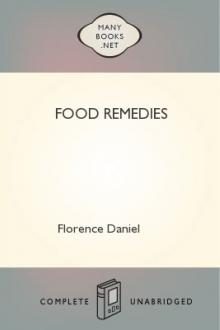The Healthy Life Cook Book, 2d ed., Florence Daniel [most romantic novels txt] 📗

- Author: Florence Daniel
- Performer: -
Book online «The Healthy Life Cook Book, 2d ed., Florence Daniel [most romantic novels txt] 📗». Author Florence Daniel
There are proper gem pans, made of cast iron (from 1s.) for baking this bread, and the best results are obtained by using them. But with a favourable oven I have got pretty good results from the ordinary baking-tins with depressions, the kind used for baking small cakes. But these are a thinner make and apt to produce a tough crust.
4. HOT WATER ROLLS.This bread has a very sweet taste. It is made by stirring boiling water into any quantity of meal required, sufficient to form a stiff paste. Then take out of the basin on to a board and knead quickly with as much more flour as is needed to make it workable. Cut it into small rolls with a large egg-cup or small vegetable cutter. The quicker this is done the better, in order to retain the heat of the water. Bake from 20 to 30 minutes.
5. OATCAKE.Mix medium oatmeal to a stiff paste with cold water. Add enough fine oatmeal to make a dough. Roll out very thinly. Bake in sheets, or cut into biscuits with a tumbler or biscuit cutter. Bake on the bare oven shelf, sprinkled with fine oatmeal, until a very pale brown. Flour may be used in place of the fine oatmeal, as the latter often has a bitter taste that many people object to. The cause of this bitterness is staleness, but it is not so noticeable in the coarse or medium oatmeal. Freshly ground oatmeal is quite sweet.
6. RAISIN LOAF.1 lb. fine wholemeal, 6 oz. raisins, 2 oz. Mapleton's nutter, water.
Well wash the raisins, but do not stone them or the loaf will be heavy. If the stones are disliked, seedless raisins, or even sultanas, may be used, but the large raisins give rather better results. Rub the nutter into the flour, add the raisins, which should be well dried after washing, and mix with enough water to form a dough which almost, but not quite drops from the spoon. Put into a greased tin, which should be very hot, and bake in a hot oven at first. At the end of twenty minutes to half an hour the loaf should be slightly browned. Then move to a cooler shelf, and bake until done. Test with a knife as for ordinary cakes.
For this loaf a small, deep, square-cornered tin is required (price 6-1/2d.), the same as for the egg loaf. 3 ozs. fresh dairy butter may be used in place of the 2 ozs. nutter.
7. SHORTENED BREAD.Into 1 lb. wholemeal flour rub 4 ozs. nutter or 5 ozs. butter. Mix to a stiff dough with cold water. Knead lightly but well. Shape into small buns about 1 inch thick. Bake for an hour in a moderate oven.
II.—SOUPS.Soups are of three kinds—clear soups, thick soups, and purées. A clear soup is made by boiling fruit or vegetables (celery, for example) until all the nourishment is extracted, and then straining off the clear liquid. A little sago or macaroni is generally added and cooked in this. When carrots and turnips are used, a few small pieces are cut into dice or fancy shapes, cooked separately, and added to the strained soup. Thick soups always include some farinaceous ingredients for thickening (flour, pea-flour, potato, etc.). Purées are thick soups composed of any vegetable or vegetables boiled and rubbed through a sieve. This is done, a little at a time, with a wooden spoon. A little of the hot liquor is added to the vegetable from time to time to assist it through.
1. BARLEY BROTH.1 carrot, 1 turnip, 4 leeks or 3 small onions, 4 sprigs parsley, 4 sticks celery, 1 tea-cup pearl barley, 3 qts. water. (The celery may be omitted if desired, or, when in season, 1 tea-cup green peas may be substituted.)
Scrub clean (but do not peel) the carrot and turnip. Wash celery, parsley, and barley. Shred all the vegetables finely; put in saucepan with the water. Bring to the boil and slowly simmer for 5 hours. Add the chopped parsley and serve.
2. CREAM OF BARLEY SOUP.Make barley broth as in No. 1. Then strain it through a wire strainer. Squeeze it well, so as to get the soup as thick as possible, but do not rub the barley through. Skin 1/2 lb. tomatoes, break in halves, and cook to a pulp very gently in a closed saucepan (don't add water). Add to the barley soup, boil up once, and serve.
In cases of illness, especially where the patient is suffering from intestinal trouble, after preparing as above, strain through a fine muslin. It should also be prepared with distilled, or clean boiled rain-water.
3. CLEAR CELERY SOUP.1 head celery, 2 tablespoons sago, 2 qts. water.
Wash the celery, chop into small pieces, and stew in the water for 2 hours. Strain. Wash the sago, add it to the clear liquid, and cook for 1 hour.
For those who prefer a thick soup, pea-flour may be added. Allow 1 level tablespoon to each pint of soup. Mix with a little cold water, and add to the boiling soup. One or two onions may also be cooked with the celery, if liked.
4. CHESTNUT SOUP.1 lb. chestnuts, 1-1/2 oz. nutter or butter, 2 tablespoons chopped parsley, 1 tablespoon wholemeal flour, 1-1/2 pints water.
First put on the chestnuts (without shelling or pricking) in cold water, and boil for an hour. Then remove shells and put the nuts in an enamelled saucepan with the fat. Fry for 10 minutes. Add the flour gradually, stirring all the time, then add the water. Cook gently for half an hour. Lastly, add the parsley, boil up, and serve.
It is rather nicer if the flour is omitted, the necessary thickness being obtained by rubbing the soup through a sieve before adding the parsley. Those who do not object to milk may use 1 pint milk and 1 pint water in place of the 1-1/2 pints water.
5. FRUIT SOUP.Fruit soups are used extensively abroad, although not much heard of in England. But they might be taken at breakfast with advantage by those vegetarians who have given up the use of tea, coffee and cocoa, and object to, or dislike, milk. The recipe given here is for apple soup, but pears, plums, etc., may be cooked in exactly the same way.
1 lb. apples, 1 qt. water, sugar and flavouring, 1 tablespoon sago.
Wash the apples and cut into quarters, but do not peel or core. Put into a saucepan with the water and sugar and flavouring to taste. When sweet, ripe apples can be obtained, people with natural tastes will prefer no addition of any kind. Otherwise, a little cinnamon, cloves, or the yellow part of lemon rind may be added. Stew until the apples are soft. Strain through a sieve, rubbing the apple pulp through, but leaving cores, etc., behind. Wash the sago, add to the strained soup, and boil gently for 1 hour. Stir now and then, as the sago is apt to stick to the pan.
6. HARICOT BEAN SOUP.2 heaped breakfast-cups beans, 2 qts. water, 3 tablespoons chopped parsley or 1/2 lb. tomatoes, nut or dairy butter size of walnut, 1 tablespoon lemon juice.
For this soup use the small white or brown haricots. Soak overnight in 1 qt. of the water. In the morning add the rest of the water, and boil until soft. It may then be rubbed through a sieve, but this is not imperative. Add the chopped parsley, the lemon juice, and the butter. Boil up and serve. If tomato pulp is preferred for flavouring instead of parsley, skin the tomatoes and cook slowly to pulp (without water) before adding.
7. LENTIL SOUP.4 breakfast-cups lentils, 1 carrot, 1 turnip, 2 onions, 4 qts. water, 4 sticks celery, 2 teaspoons herb powder, 1 tablespoon lemon juice, 1 oz. butter.
Either the red, Egyptian lentils, or the green German lentils may be used for this soup. If the latter, soak overnight. Stew the lentils very gently in the water for 2 hours, taking off any scum that rises. Well wash the vegetables, slice them, and add to the soup. Stew for 2 hours more. Then rub through a sieve, or not, as preferred. Add the lemon juice, herb powder, and butter (nut or dairy), and serve.
8. MACARONI SOUP.1/2 lb. small macaroni, 2 qts. water or vegetable stock, 3/4 lb. onions or 1 lb. tomatoes.
Break the macaroni into small pieces and add to the stock when nearly boiling. Cook with the lid off the saucepan until the macaroni is swollen and very tender. (This will take about an hour.) If onions are used for flavouring, steam separately until tender, and add to soup just before serving. If tomatoes are used, skin and cook slowly to pulp (without water) before adding. If the vegetable stock is already strong and well-flavoured, no addition of any kind will be needed.
9. PEA SOUP.Use split peas, soak overnight, and prepare according to recipe given for lentil soup.
10. POTATO SOUP.Peel thinly 2 lbs. potatoes. (A floury kind should be used for this soup.) Cut into small pieces, and put into a saucepan with enough water to cover them. Add three large onions (sliced), unless tomatoes are preferred for flavouring. Bring to the boil, then simmer until the potatoes are cooked to a mash. Rub through a sieve or beat with a fork. Now add 3/4 pint water or 1 pint milk, and a little nutmeg if liked. Boil up and serve.
If the milk is omitted, the juice and pulp of two or three tomatoes may be added, and the onions may be left out also.
11. P.R. SOUP.1 head celery, 4 large tomatoes, 4 qts. water, 4 large English onions, 3 tablespoons coarsely chopped parsley.
This soup figures often in the diet sheet of the Physical Regenerationists for gouty and rheumatic patients, but in addition to being a valuable medicine on account of its salts, it is the most delicious clear soup that I know of. To make: chop the ingredients to dice, cover closely, and simmer until the quantity of liquid is reduced to one half.
12. P.R. BEEF TEA SUBSTITUTE.1/4 pint pearl barley, 1/4 pint red lentils, 2 qts. cold bran water, flavouring.
To make the bran water, boil 1 measure of bran with 4 measures of water for not less than 30 minutes. Simmer together the barley, lentils, and bran water for 3 hours. To flavour, put 4 ozs. butter or 3 ozs. nutter into a pan with 1 lb. sliced onions. Shake over fire until brown, but do not let them burn or the flavour of the soup will be spoilt. Add these to the stock at the end of the first hour. Any other vegetable liked may be chopped to dice and added.
Tomato may be substituted for the onion if preferred and no fat used.
Strain through a hair sieve, and serve the clear liquid after boiling up.
6 ozs. sago, 2 qts. stock, juice of 1 lemon.
Wash the sago and soak it for 1 hour. Put it in a saucepan with the lemon juice and stock, and stew for 1 hour.
14. TOMATO SOUP.1 qt. water or white stock, 1 lb. tomatoes.
Slice the tomatoes, and simmer very gently in the water until tender. Rub through a sieve. Boil up and serve.
15. VEGETABLE STOCK.To 4 qts. water allow 1 pint lentils, or rather less than 1 pint haricots. In addition allow 1 carrot, 1 turnip, 1 onion, and 1/4 head of celery. Clean apple peelings and cores, and any fresh vegetable cuttings may also be added with advantage. For white stock, use the white haricot beans, rice, or macaroni in place of lentils or brown haricots. Soak the pulse overnight, and simmer with the vegetables for 4 hours. Any stock not used should be emptied out of the stock pot, and boiled up afresh each day.
III.—SAVOURY DISHES.The recipes following are intended to be used as substitutes for meat, fish, etc.
The body needs for its sustenance water, mineral salts, [Footnote: I allude to mineral salts as found in the vegetable kingdom, not to the manufactured salts, like the ordinary table salt, etc., which are simply poisons when taken as food.] fats





Comments (0)